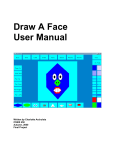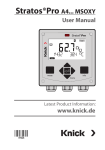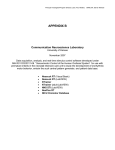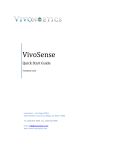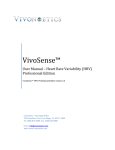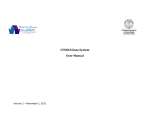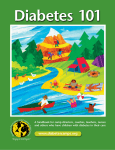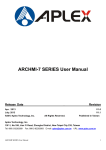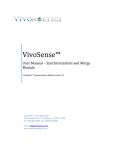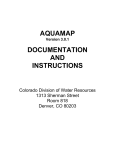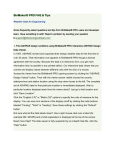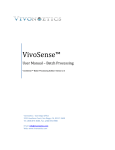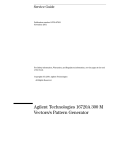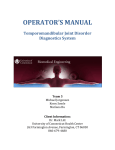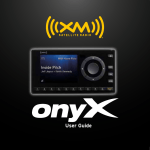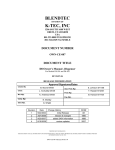Download Colorado Responds to Children with Special Needs (CRCSN) and
Transcript
Colorado Responds to Children with Special Needs (CRCSN) and Health Care Program for Children with Special Needs (HCP Community Notification and Follow-up Manual November, 2006 Table of Contents Key Contacts ……………………………………………………………….2 What is CRCSN ……………………………………………………………3 Health Care Program for Children with Special Needs (HCP) Connecting Kids with Care ……………………………………...…5 Eligibility Criteria for CRCSN ……………………………………………6 Colorado Responds to Children with Special Needs Flow Chart ……….7 How CRCSN Helps Families……………………………………………….8 How are Children Identified by CRCSN……………………………...…..9 Community Notification and Referral Process ………..…………..……10 2005 Notifications by County …………………………..……………..….11 Using the CRCSN Web Site …………………………….…………..……12 How can I find data for my county? Confidentiality ……………………………………….………………..….14 Check List for Keeping Information Confidential ………………16 Appendix ……………………………………………….…………..……..18 CRCSN Follow-up Letter #1 CRCSN Follow-up Letter #2 HCP Web Site at www.hcpcolorado to access: CRCSN/HCP Community Notification and Follow Up Manual CRCSN/HCP Notification Follow-up Policy and Procedures CRCSN/HCP/CHIRP User’s Guide for HCP CRCSN Follow-up Letter #1 Template (English and Spanish) CRCSN Follow-up Letter #2 Template (English and Spanish) 1 Key Contacts Colorado Department of Public Health and Environment Barbara Deloian, PhD, RN, CPNP Nursing Consultant Health Care Program for Children with Special Needs (HCP) Phone: 303-692-2303, 1-800-886-7689 E-mail: [email protected] Amy Alman CRCSN Data Manager Phone: 303-692-2612 E-mail: [email protected] Margaret Ruttenber Program Manager, Environmental Health Studies and Colorado Responds to Children with Special Needs (CRCSN) Phone: 303-692-2636 E-mail: [email protected] April Montgomery Prevention Projects Coordinator Colorado Responds to Children with Special Needs (CRCSN) Phone: 303-692-2620 E-mail: [email protected] Shirley Babler, RD Data Owner, HCP CHIRP Children and Youth with Special Health Care Needs Section Phone: 303-692-2455 E-mail: [email protected] KaraAnn Donovan, MSPH Epidemiologist/Statistician Children and Youth with Special Health Care Needs Section Phone: 303-692-2417 E-mail: [email protected] 2 What is CRCSN? What is Colorado Responds to Children with Special Needs? Colorado Responds to Children with Special Needs (CRCSN) is the birth defects monitoring and prevention program at the Colorado Department of Public Health and Environment. The program began in 1989 under the guidance of an advisory board of parents, physicians, advocates, and representatives from state agencies. What is the purpose of Colorado Responds to Children with Special Needs? to maintain a statewide, database of pregnancies and young children with birth defects, developmental disabilities, or risk factors for developmental delay to monitor and investigate the occurrence of birth defects and developmental disabilities to prevent birth defects and secondary disabilities due to birth defects and to help connect children and families with early intervention services in their communities to provide accurate, aggregate statistics and an unduplicated count of children with special needs to other programs and agencies for program planning to provide statistics to researchers studying causes and risks, the ultimate goal being to prevent future birth defects and developmental disabilities What information is collected? Colorado Responds to Children with Special Needs collects information about birth defects among Colorado residents diagnosed before birth and up to age three with one of the conditions eligible for the program. Eligible conditions are listed on a following page. Children meeting these criteria are identified from many sources including hospitals, vital records (birth, death, and fetal death certificates), the Newborn Genetic Screening Program, the Newborn Hearing Screening Program, laboratories, prenatal diagnostic centers, physicians, and genetics, developmental, and other specialty clinics. About four percent of all births have major congenital anomalies. About 8,000 children or 13 percent of all the births in Colorado each year are identified because they meet CRCSN eligibility criteria, which include risks for developmental delay. What is CRCSN’s authority? The legal authority to collect birth defects information is based on a statute authorizing the Colorado Department of Public Health and Environment to develop and maintain a system for detecting and monitoring conditions that contribute to preventable or premature sickness, disability, or death (C. R. S. 25-1.5-101 to 25-1.5-105). Under Colorado Board of Health 3 regulations (6 CCR-1009-7) hospitals, health care facilities, and laboratories are required to report birth defects, developmental disabilities, and chromosomal abnormalities diagnosed prenatally and up to age three. Physicians are required to report suspected or confirmed fetal alcohol syndrome under age ten, autism under age ten, and muscular dystrophy. Does CRCSN focus on any special conditions? The program has several surveillance and prevention projects that focus on specific conditions including fetal alcohol syndrome, autism, neural tube defects such as spina bifida, cleft lip/cleft palate and muscular dystrophy. CRCSN collaborates with other agencies, programs, and family support groups concerned with these conditions. Additional information on these projects can be obtained by calling CRCSN. Program staff also respond when citizens are concerned about birth defects in their communities. 4 Health Care Program for Children with Special Needs Connecting Kids with Care The Health Care Program for Children with Special Needs (HCP) is a unique resource for families, health care providers, and communities. Our goal is to help improve the health, development and well –being of Colorado’s children with special health care needs and their families. Families turn to HCP for information, referral, and support. HCP also works with communities and policy makers to strengthen our state’s capacity to meet the needs of children and their families. HCP services children from birth to age 21 that have, or are at risk for, serious physical, behavioral or emotional conditions. HCP has regional offices and partners throughout Colorado. Each works with families, providers, and communities to connect kids with the care they need, and to help coordinate that care over time. Anyone who believes that Colorado’s diverse children with special health care needs should have the opportunity to live the healthiest life possible will find expert help at HCP. 5 Eligibility Criteria for CRCSN Resident of Colorado Diagnosed prenatally to the third birthday Diagnosed as having one of the following conditions CONGENITAL ANOMALIES MEDICAL DIAGNOSES & RISK FACTORS FOR DEVELOPMENTAL DELAY Central nervous system Cardiovascular Circulatory Respiratory Eye, ear, and face Orofacial Gastrointestinal Genitourinary Musculoskeletal Chromosomal abnormalities Congenital anomaly syndromes Birth Outcomes and Perinatal Conditions Birth weight less than 1500 grams Prematurity less than 32 weeks gestation Small for gestational age APGAR 3 or less at five minutes Meconium aspiration syndrome Birth trauma Intracranial hemorrhage Convulsions / seizures Drug withdrawal syndrome in the Newborn Noxious influences affecting fetus Fetal alcohol syndrome Congenital perinatal infections GENETIC, ENDOCRINE, & METABOLIC DISORDERS Phenylketonuria (PKU) Congenital hypothyroidism Hemoglobinopathies Galactosemia Cystic fibrosis Biotidinase deficiency Congenital adrenal hyperplasia Disorders of amino acid transport and metabolism Disorders of carbohydrate transport and metabolism Lipidoses Disorders of copper metabolism Other disorders of purine and pyrimidine metabolism Mucopolysaccharidoses Sensory, Development and Growth Conditions Hearing Loss Blindness and low vision Retinal degeneration Speech and motor delays Growth and weight delay Mental retardation Infantile cerebral palsy Dystrophy: muscular and spinal Degenerative CNS / Cerebral Lipidoses Other Risk Factors for Developmental Delay Encephalitis Meningitis Injury: head and spinal cord Cerebral cysts Child maltreatment syndrome Chorioretinitis Infantile spasms Renal tubular acidosis 6 Colorado Responds to Children with Special Needs Flow Chart Sources of the Data Uses of the Data Birth certificates Death and fetal death certificates Hospital discharge data Birth defects monitoring Demographic information from birth certificates Investigating community concerns Linking families to services Newborn hearing screening Newborn genetics screening Agency program planning Autopsy reports National statistics Prenatal diagnostic centers Requests for information Genetics laboratories Specialty clinics CRCSN Database Website Child development clinics Research Physician reports Education for professionals Other - public health surveillance systems and epidemiological Information for parents 7 How CRCSN Helps Families e r a C h t l a e H e h t h t i w s e t a r o b a l l o c N S C R C s s e y d c t i i e v n e r Nus e m lm a h i t c i ow e c p d s S n e i ha l t i i sm e w i a f nct n e e r c g d e a l n i n h ho Ct l c a re o o ht f s )ce i P l c b Cu i v Hp r e ( ls ma g acn o r i l g s d r o u r n P n a talking to the representative had helped their child or family, and 22 percent named a specific service that they had received as a result of the contact with a community representative. How Do Communities Use CRCSN? ” : e d u l c n i y a m s e c i v r e s “ e h T . s i s a b s s i m r o t i h a n o s e c i v r e s t u o h c r a e s ’ n o i t a u l a v e l a t n e m p o l e v e D d n a s g n i h . t r e yt n t a e mb n do l i s h r c u ro u d o n ta h t g s r u e a d t n eu v a s h u ye d e h p l T e h ” t. s r s i t F i s i ov t sl y t n h e t r n a o p m dg e r n r i e v f i e e r c e er v i s t i a t d n l i e h s c e r d p n e a r ep s h e T t S y a w ,e o d h t ot t u t o a b h a ws nu o o nt o d i e t a n e ms t r i o l f n d i n ea , mo eg v o a . t t g l ee r ye f e he h ww T e c n a t s i s s a l a i c n a n i F ” s p u o r g t r o p p u s t n e r a P “ e r a c lss a e e c c i s i d s v a e r l e ms c g ynn t o l i i a t t i n i c r e t e r u p a NP S “ y p a r e h t g hi n c s e r e u p n s h dl t n a a e lh a c c i i s l y b h u P P ” s m a r g o r p n o i t n e v r e t n i y l r a E y r e e g a h n i T y o f d e . o h s t et eu r r a o a h t e we wt. al s g u t sb a n a u d l i h h t ei n a t i d e v y m a r a n u e md a s r en d eye a v k l ln i e a t d a a e m u t r e n n e o i w e f t t f s n l f o e o l i r a c s p e c e l m d r b asn a y r eg a l a i h a o Kv w T r l Oa p a tt o s en u h t m e sr a d e t n n i r a e r w m d l ri e o h h t ,c s o t g i t s n i e u v l b ,oa y s l l i l h a a t i v c a ews s s r e e u i c l r n i u hmo t a s l f e a r e ye h n h a cM t i l f b o . u y e p l r i a am w sf aa a ” How are families helped by CRCSN? n o s t s dt e i d g hi n ti c e r g a h rwe h e h d d t n n o i a mF g ddi n l i e n h p e l Ce e r h tc eus o v l b i a a t t a n t ne n o e i m t s a p e r o m . l p r d e e o l v i R f e h n d c i “ ” r e h t e h w l o r t n o c s t n e r a P . e g r a h c n i e r a s t n e r a P h t i w d e r a h s s i d l i h c r i e h t ts . u r o e b d a i v no o r i p t a e mc i rv o r f e n s i Community agencies have contacted about 30 percent of the families that CRCSN has identified. Of those families contacted, more than a third were referred to developmental screening, school district programs, public health programs, early intervention services, support groups, or other services. Families find the contact with a local community agency to be valuable. Of 172 families surveyed by phone in 2003 , 46 percent said they learned about available services or resources, 44 percent said that 8 e r e h t s i e. r s e u h t h t t i u w o yu p d o g b n e i mw oo l l :so s w t f n o s e n i r k a d p oa n ets e h c t u i eN r t o o f u q o T h c u s e v i t a t n e s e r p e r A . s e i t i n u m m o c n w o r i e h t n i “ How are Children Identified by CRCSN? letters cannot be delivered and 15% are returned by the parent requesting that information on their child not be released. The majority of the children referred to the local agencies are identified through birth certificates and hospital discharge data. Experience shows that the local agencies are already aware of and have had contact with about a fourth of the families. The parent also has the option of calling someone at CRCSN to ask about the letter. A CRCSN staff member answers any questions and urges the parent to keep the letter in order to allow a public health nurse to contact them. The parent is often provided with the name and the phone number of the HCP nurse in their county so that the parent may contact you directly without waiting. Be aware that parents may contact you directly before the notification is sent to you. They will probably mention that they received a letter from the state health department. The letter is on yellow paper and does not mention either CRCSN or HCP. Birth Certificates There are some differences in the procedures and in the information that CRCSN receives from hospitals and from birth certificates. Information on the birth certificate is collected by Vital Records. The majority of the babies identified from birth certificates are premature (less than 32 weeks gestation) or low birth weight (under 1500 grams) and some have low Apgar scores. Release of information from birth certificates is restricted by statute and Board of Health Regulations. Information from birth certificate records is provided to CRCSN without personal identifiers such as name, address and parent/guardian names. If the child was identified from birth certificate data, the parents or guardians are sent a letter from the State Registrar of Vital Statistics, notifying them that their child might be eligible for services. A copy of this Negative Consent letter follows. They are asked to return the letter within three weeks if they do not wish to be contacted by a local public health agency. • If the parent/guardian returns the letter or the letter cannot be delivered by the post office, no personal information is collected and your agency is not notified of the child. • If the parent or guardian does not return the letter within the three weeks, information concerning the child is released to you for followup. Approximately 77% of parents imply consent by not returning the letter, 8% of the Hospital Discharge Data The information on hospital discharge data is more accurate for birth defects and other eligible conditions so that most birth defects are identified through hospital data. The restrictions that apply to birth certificates relating to parent and child names and identifying information do not apply to hospital discharge data or other sources of information. Therefore, the parents of children identified through hospital data have NOT received a negative consent letter. Your contact will be the first contact with this familiy. Selecting Children for Notification Prior to notifying the local agencies, children’s names are matched to death certificates to ensure that the families of children who have died are not contacted. Single minor conditions that are not risks for developmental delays or special needs are excluded from notification. 9 Colorado Responds to Children with Special Needs Community Notification and Referral Process CRCSN generates Notifications and transmits data to HCP Database Data is processed and sent to HCP/CHIRP Already known to HCP – ALERT sent to HCP Care Coordinator and HCP Staff New children – ALERT sent to HCP /CHIRP site for child’s county of residence (HCP Staff assigns HCP Care Coordinator) New Case (Unknown) Already Existing in CHIRP (Known) HCP Staff with “Notify Authority” gets ALERT HCP Care coordinator and RO staff with “Notify Authority” gets ALERT (both RO and county site of child’s residence) Regional Office Staff completes triage (need to F/U) Care Coordinator is assigned by RO HCP expectation is two (2) attempted contacts documented in HCP CHIRP Communication (see Type of Communication in Appendix and CHIRP User Manual) Care Coordinator determines the level of Care Coordination Reply to CRCSN is documented in HCP CHIRP by Care Coordinator within 90 days from receipt of the ALERT (see Type and Reply responses in CHIRP User Guide) The Reply response is processed by the database and follow-up data is sent to CRCSN Acronyms: HCP – Health Care Program for Children with Special Needs RO – HCP Regional Office CHIRP – Database used by HCP to document Care Coordination Services (Clinical Health Information Records of Patients) NEST – State Integrated Database used to facilitate notifications to HCP for follow-up. (Newborn Evaluation Screening and Tracking) 10 CRCSN Notifications by County 2005 Jan Adams Alamosa Arapahoe Archuleta Baca Bent Boulder Broomfield Chaffee Conejos Crowley Delta Denver Dolores Douglas Eagle El Paso Elbert Fremont Garfield Gilpin Grand Gunnison Huerfano Jefferson Kit Carson La Plata Lake Larimer Las Animas Lincoln Logan Mesa Moffat Montezuma Montrose Morgan Otero Park Phillips Pitkin Prowers Pueblo Rio Blanco Rio Grande Routt Saguache San Miguel Sedgwick Summit Teller Washington Weld Yuma Total 28 2 26 1 0 0 12 4 0 0 0 0 51 0 13 0 43 2 2 3 0 1 0 0 23 1 1 1 17 1 1 1 6 1 1 0 1 3 1 0 0 2 7 1 1 0 0 0 1 1 0 0 12 0 Feb Mar 33 1 42 0 0 1 16 1 1 0 0 1 55 0 26 0 34 1 2 3 0 0 0 0 32 0 1 0 14 2 0 0 8 0 1 3 0 0 1 0 0 0 12 0 1 0 0 1 0 1 0 0 19 0 30 1 45 0 0 1 19 1 0 1 0 2 55 0 21 2 35 1 3 2 0 0 0 1 19 0 1 2 8 0 0 1 5 1 1 1 1 0 0 0 1 0 9 0 1 1 1 0 1 1 2 0 18 0 Apr May 30 1 27 0 0 0 14 1 2 1 0 2 42 0 18 3 29 0 0 3 1 1 0 0 24 1 1 0 9 1 0 0 8 2 1 2 1 1 0 0 0 0 13 1 0 4 0 1 0 2 0 0 13 0 Jun 6 0 3 0 0 0 8 1 0 0 0 3 27 0 10 0 17 0 0 0 0 0 0 0 11 0 1 0 12 0 0 2 9 1 0 2 0 0 2 0 0 0 1 1 1 0 1 0 0 0 1 0 15 0 47 2 50 0 0 1 15 1 0 0 1 0 56 0 23 2 57 2 3 6 0 1 2 0 47 0 1 1 13 1 1 2 9 1 0 5 2 1 0 0 0 1 18 0 2 1 0 0 0 0 3 1 18 1 Page 1 Jul 44 0 31 0 0 0 17 4 0 0 0 0 44 0 30 2 16 1 1 1 0 0 0 0 24 0 1 0 16 2 0 2 6 0 2 1 2 0 1 1 0 1 9 0 2 0 0 0 1 1 1 0 12 2 Aug 30 1 46 0 1 0 15 2 2 0 0 4 59 1 12 3 42 0 2 3 0 1 0 2 24 0 0 0 11 0 0 1 9 1 1 2 2 2 1 0 0 0 19 0 2 0 0 0 0 2 1 0 24 0 272 313 295 260 135 398 278 328 11 Sep 7 1 16 0 0 1 2 0 0 1 0 2 19 0 6 0 8 1 0 1 0 0 0 0 8 0 2 0 3 0 0 2 1 0 0 0 0 0 0 0 0 0 0 0 0 0 0 0 0 0 1 0 11 0 Oct 16 0 11 0 0 0 4 7 1 0 0 0 18 0 7 3 8 0 0 0 0 0 2 0 8 0 1 0 6 0 0 1 1 0 0 0 1 0 0 0 0 1 6 0 0 0 0 1 0 1 0 0 6 0 Nov 69 2 61 0 1 2 30 7 0 2 0 0 95 0 34 6 66 1 6 5 0 5 1 0 43 0 4 2 28 2 0 0 13 2 1 3 1 1 0 0 5 4 26 1 3 1 0 0 0 4 4 1 24 2 Dec Total 28 1 36 0 0 0 12 4 0 0 1 2 58 0 18 3 25 2 1 0 0 0 1 0 21 0 0 0 7 1 3 0 2 1 1 2 2 1 0 0 1 1 3 0 0 2 0 0 0 2 4 1 7 0 368 12 394 1 2 6 164 33 6 5 2 16 579 1 218 24 380 11 20 27 1 9 6 3 284 2 14 6 144 10 5 12 77 10 9 21 13 9 6 1 7 10 123 4 13 9 2 3 3 15 17 3 179 5 93 110 568 254 3304 Using the CRCSN Web Site 2. Selected Diagnosis Counts Based on Live Births by Year of Birth (19992003) – by county of residence 3. Number of Live Births by Year of Birth (1999-2003) – by county of residence and for all Colorado How to Find the CRCSN Web Site The computer address for this web site is www.cdphe.state.co.us/dc/crcsn/crcsnhome.asp You can type this address into the address line on your web browser. This will bring you to the CRCSN home page, which gives a brief overview of the purposes of CRCSN. When you are ready to obtain data from the web site, click on the option "Introduction to Tables." The text describes the layout of the tables and the type of data that you will find in them. Reading this page at least once is recommended. The next time you come to this point, you can click on the words “Data Tables" near the top of the introduction and it will take you to the list of tables. You can obtain counts by year of birth for children who were diagnosed with many different types of congenital anomalies, either by broad categories such as “major congenital anomalies" or by more specific categories. (For a list of the possible categories, click on the last table on this list, “ICD9-CM Codes for Diagnostic Categories, The second table format presents data as diagnosis counts, counts, prevalence rates, and 95% exact binomial confidence limits for all years of birth combined. The tables using this format include: What Data is Found There? Per this introduction “In each of the tables, major congenital anomalies appear at the beginning, followed by congenital anomalies and related conditions ordered by body system.“ Data are presented in two different table formats and are either for all Colorado residents, or by county of residence at the time of birth. Since some children have more than one of these conditions and since the categories listed in these tables are both general and specific, children may be listed in more than one category on these tables. Be aware that summing the rows in different directions will not add up the same way that they would if all children were only listed once on the table. 1. Query and Summarize Data from the CRCSN Dataset 2. Selected Diagnosis Counts and Rates based on Live Births (1999-2003) Combined, by county of residence 3. Selected Diagnosis Counts and Rates Based on Live Births by Year of Birth (1999-2003) by county of residence. How can I find data for my county? There are two different methods of finding data specific to your county. The first way is to click on the first option listed, “Query and Summarize Data from the CRCSN Dataset." This brings you to the Colorado Health Information Dataset, or “COHID." You will notice from the other options listed at the left side of the screen that you can also use this Tables presented in the format of diagnosis counts (by year of birth) include: 1. Selected Diagnosis Counts Bases on Live Births (1999-2003) – Combined by all Colorado Residents 12 page to access other types of information about state data, including birth and death statistics, cancer statistics ad behavioral risk factor data. A Second Way to Find County Data For another way to look at county level data, select the fifth table listed on the CRCSN “Introduction to Tables," which is called “Selected Diagnosis Counts and Rates Based on Live Births by Year of Birth (1999-2003) – by county of residence." Clicking on this choice brings up a list of counties. Select your county and click on it. This will bring up a list of congenital anomalies per county by year of birth of the affected children. You can then scroll through the list of anomalies until you find the condition in which you are interested. Refer to the discussion above regarding the use of counts and rates. Summary of Steps to Find County Data by the First Method 1. From your Web Browser, go to www.cdphe.state.co.us/dc/crcsn/crcsnhome .asp 2. Select Introduction to Tables 3. Choose Query and Summarize Data from the CRCSN Dataset 4. Select your County (or the county of interest) 5. Select the time period that you want to look at (1999-2003 for this example) 6. Select race and ethnicity of mother (all races, all ethnicities for this example) 7. Select age range for the children (all ages, for this example) 8. Select the gender of the children (all genders, for this example) 9. Select the type of congenital anomaly or birth defect that you want to investigate (major congenital anomalies, for this example) 10. Select count or rate (rate, for this example) 11. Click on submit. Questions If you have any questions about how to obtain data from the CRCSN web site, please call statistical analyst KaraAnn Donovan at 303692-2417. For specific questions about detailed data found in the tables, Russ Rickard at 303-692-2723 is the contact. 13 CONFIDENTIALITY The information on children and their families that CRCSN shares with local agencies must be kept confidential and can not be shared with other agencies unless the parent or guardian signs a consent to release that information to that agency. State law requires that parents or guardians sign a release form before information that identifies individuals from CRCSN can be shared with any other agency. Of course, no release of information form is required if the parent or guardian chooses to contact the agency or services providers themselves. Informing a parent or guardian of services and resources available in the community and encouraging them to contact the other program directly does not require a signed release. Statutory and Regulatory Protection The Colorado Department of Public Health and Environment has statutory (CRS 25-1.5-101 to 25-1.5105) and regulatory (Board of Health, Rules and Regulations Pertaining to the Detection, Monitoring, and Investigation of Environmental and Chronic Diseases, 6 CCR 1009-7, attached) authority to collect information regarding conditions such as birth defects and developmental disabilities. The confidentiality of this information is protected by CRS 25-1-122. It states that such information held by state and local health departments "...shall be strictly confidential. Such reports and records shall not be released, shared with any agency or institution, or made public, upon subpoena, search warrant, discovery proceedings, or otherwise, except...” under certain limited circumstances. Staff at state and local health departments and county nursing services are all subject to the provisions of the law. "Any officer or employee or agent of the state or local department of health who violates this section by ‘releasing or making public confidential public health reports or records or by otherwise breaching the confidentiality requirements commits a class 1 misdemeanor and, upon conviction thereof, shall be punished as provided in section 18-1-106 (1), CRS". CRCSN is a secondary holder of data, with stricter confidentiality protocols and protections than many of the original sources. 14 Birth Certificate Information Some newborns are identified through information on the birth certificate collected by Vital Records. The majority of the babies identified from birth certificates are premature or low birth weight and some have low APGAR scores. The information on hospital discharge data is more accurate for birth defects and other eligible conditions so that most birth defects are identified through that means. Release of information from birth certificates is restricted by statute and Board of Health Vital Statistics Regulations. Information on children who are eligible for CRCSN because they have a birth weight below 1500 grams and/or are premature (less than 32 weeks gestation) is collected from birth certificate records without personal identifiers such as name, address and parent/guardian names. If the child was identified from birth certificate data, the parents or guardians are sent a letter from the State Registrar of Vital Statistics, notifying them that their child might be eligible for services. A copy of the letter follows. They are asked to return the letter within three weeks if they do not wish to be contacted by a local public health agency. • If the parent/guardian returns the letter or the letter cannot be delivered by the post office, no personal information is collected and your agency is not notified of the child. • If the parent or guardian does not return the letter within the three weeks, information concerning the child is released to you for follow-up. Approximately 77% of parents imply consent by not returning the letter, 8% of the letters cannot be delivered and 15% are returned by the parent requesting that information on their child not be released. Sharing Confidential Information Under the State Board of Health Regulations, state health department programs such as CRCSN and HCP and local health departments and community nursing services can share confidential information about individuals with eligible conditions with one another. Each agency and their employees are subject to the statutes. Every employee having access to CRCSN information should be given a written explanation of the confidentiality requirements before having access to confidential data. Each organization must obtain a written release from the parents before sharing personal identifying information with any other agency. HCP sets guidelines for contacting the families. Health Insurance Portability & Accountability Act of 1996 (HIPAA) The HIPAA statutes of 1996 brought about heightened awareness of privacy and security issues for all who work with protected health information. The HIPAA regulations define health information as “any information, whether oral or record in any form or medium” that connects or links any potentially identifiable individual with any physical or mental health or condition. Of course a “6 month-old child” in some small Colorado towns might actually be enough to identify that individual. In order to protect the privacy of the confidential information, it becomes necessary to protect the security of the data. 15 Checklist for Keeping Information Confidential It is important to consider all of the ways in which someone could become aware of the identifying information about these children or families. In general, you should prevent anyone else, even within your program and agency, from becoming aware of identifying information about the child and the family. If you are supposed to share information with someone else within your agency, you should share only the minimum amount of information that they need to know to perform their job. In order to share information with another agency, you must have written permission or authorization from the parent or adult patient. If you are not certain if you have authorization to share the information, check with your supervisor or privacy officer. If the data is loaded onto a computer or network, access to the computer and the program needs to be password protected. Passwords must not be kept near the computer. The computer should be kept in a locked area, if possible. Recommendations for a strong password include 1. At least 8 characters long, ideally at least 20 characters 2. Use both upper and lower case letters 3. Use at least one number 4. Use at least one special character (*, &, #, $ etc.) 5. Be certain to change the password periodically. 6. Do not make it incremental: quarter1, quarter2, … 7. Do not reuse the same password. If the data was obtained electronically, the first source containing the data is your computer and possibly CDs or floppy discs. A checklist of things to consider about keeping this type of data secure include: Are the CDs and floppy discs containing confidential information kept locked up when you are not working with them? When calling families or communicating verbally about the cases, other things need to be considered. Is your computer screen situated so that visitors to your work area do not view whatever you have on the screen when they walk in? Who else is close enough to your workspace to overhear you? When you leave your desk with programs open that contain confidential data, do you at least lock the screen with a password protected screen saver? Speaking in a softer voice may decrease your chances of being overheard. If you leave a message consider carefully what words you actually say or leave out 16 that the person for whom the message is intended will already know. the name, condition, visit dates, or any identifying data. If you need to leave a message, you need to consider that someone other than the one for whom you intended the message may be the one to hear it. This means that your message cannot contain any specific information regarding any health condition. E-mails are subject to the same restrictions as actual mail, although the concern is more for the insecurity of the process of being carried to the addressee than it is for mail carried by the US Postal Service. Care also needs to be taken when sending or receiving faxes. If your print or hand write any of the confidential information about these children or their families, If the fax contains any confidential information, it should be sent to a “secure fax," which means that you can be certain that the room containing the fax machine has access limited only to people who have authorization to know the data. You need to be careful not to let anyone who does not need to know this data see this printed information. Printed materials need to be taken off the printer right away. Otherwise, you need to have the intended recipient of the fax standing by to protect the confidentiality of the data as it comes in. When working at your desk, turn over those papers that you are not actually using. (Nonconfidential stick notes help you remember which stacks are which.) This ensures that a visitor to your work area will not see information that they do not need to know. It is helpful to use a full page for the cover sheet so that it covers up the confidential information if the fax ends up sitting somewhere. When you leave your desk area for a short time, turn over all confidential papers. The full sheet cover page is also helpful for protecting confidentiality if the confirmation page prints part of the first sheet. When you leave your desk area for a longer time or for the day, make sure that all confidential papers are either shredded or locked up. The bottom line is to be careful not to share (even inadvertently) any of the confidential information that has been entrusted to your agency, either electronically, by being heard or overheard, or by letting someone see it in print. When mailing letters to the families, you need to consider that someone else might open the letters. You need to make the letters general enough that they dont share 17 Appendix A. B. CRCSN Follow-up Letter #1 Template CRCSN Follow-up Letter #2 Template 18 Local Health Dept or Nursing Services Logo A. CRCSN Follow Up Letter # 1 Template Family name Address Dear ______________________: I am a ______________________ (title) with ___________________ (name of agency), working with the Health Care Program for Children with Special Needs (HCP). We are responsible for improving the health, development, and well-being of Colorado’s children and youth, birth to 21 years of age, by connecting families with local health and developmental care and community resources. I am writing because we received information about (child’s name) from Colorado Responds to Children with Special Needs (CRCSN), who notifies us about children who may have a medical condition that is associated with special health care needs, or a condition that may place them at risk for developmental delays. As a partner in Colorado’s public health system, when CRCSN receives this information through birth certificates and/or hospital discharge information, they forward it to us so that we can assist families in accessing needed community services. I would like to speak with you to see if there are any health care, developmental, or community services that might be helpful to you. Because children and youth often recover quickly when they are ill, the information we receive does not always accurately reflect their current health or developmental status. Therefore, even if your child or youth is now healthy, we would appreciate knowing this. HCP provides services by helping coordinate care with your primary care provider, specialty providers, educational programs, and community agencies to make sure that your child and your family’s health needs are met. Specific areas that HCP may assist you with: Making sure that you have a primary care provider for your child’s health care Assisting you in accessing financial resources for health care Assisting you in connecting with community resources, especially developmental services Helping you follow up on referrals and community programs Connecting you with family support groups and respite services Answers to your questions…and more. Please call me to discuss the information that I received or answer your questions. I have information about many community resources and can make referrals to other helping agencies in the county. It would also be helpful to know from what other agencies you and (child’s name) are already receiving services. I look forward to hearing from you. Sincerely, Name: Health Care Program for Children and Youth with Special Needs (HCP) Phone Number 19 Local Health Dept or Nursing Services Logo B. CRCSN Follow Up Letter # 2 Template Date: Family name Address Dear ______________________: I am a ______________________ (title) with ___________________ (name of agency), working with the Health Care Program for Children with Special Needs (HCP). I am writing to follow up on the letter I previously sent you regarding our services of connecting children with needed health care, developmental, and community resources. I would like to talk with your about any resources or services that may needed for (child’s name), and provide you with information that might be helpful to you. Please call me if you have any questions about how our agency may be of assistance. If all is going well, I would just like to make sure you are aware of the services available in our community. As a reminder, specific areas that HCP may assist you with are: Connecting with health and developmental care Assisting you in connecting with community resources Monitoring your ability to access needed referrals and services Assisting you in accessing financial resources for health care Connecting you with family support groups and respite services Answers to your questions…and more. I look forward to hearing from you. Sincerely, Name: Health Care Program for Children and Youth with Special Needs (HCP) Phone Number E:\CRCSN CHIRP NEST 11-05\Pilot Documents most recent copies\Training 9-25-06\CRCSN HCP Manual 9-25-06.DOC 20





















